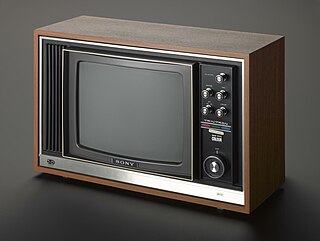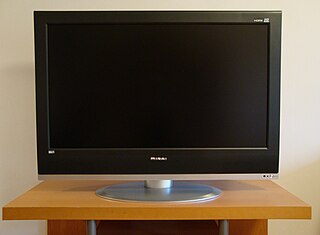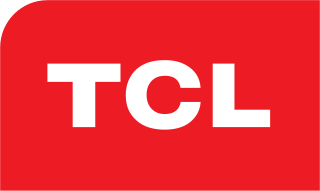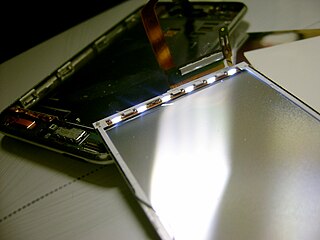
A liquid-crystal display (LCD) is a flat-panel display or other electronically modulated optical device that uses the light-modulating properties of liquid crystals combined with polarizers. Liquid crystals do not emit light directly but instead use a backlight or reflector to produce images in color or monochrome. LCDs are available to display arbitrary images or fixed images with low information content, which can be displayed or hidden: preset words, digits, and seven-segment displays are all examples of devices with these displays. They use the same basic technology, except that arbitrary images are made from a matrix of small pixels, while other displays have larger elements. LCDs can either be normally on (positive) or off (negative), depending on the polarizer arrangement. For example, a character positive LCD with a backlight will have black lettering on a background that is the color of the backlight, and a character negative LCD will have a black background with the letters being of the same color as the backlight. Optical filters are added to white on blue LCDs to give them their characteristic appearance.

Sony Group Corporation, formerly known as Tokyo Tsushin Kogyo K.K. and Sony Corporation (ソニー株式会社), is a Japanese multinational conglomerate corporation headquartered in Minato, Tokyo, Japan. The Sony Group comprises entities such as Sony Corporation, Sony Semiconductor Solutions, Sony Entertainment, Sony Interactive Entertainment, Sony Financial Group, and others.

Trinitron was Sony's brand name for its line of aperture-grille-based CRTs used in television sets and computer monitors, one of the first television systems to enter the market since the 1950s. Constant improvement in the basic technology and attention to overall quality allowed Sony to charge a premium for Trinitron devices into the 1990s.

Kyocera Corporation is a Japanese multinational ceramics and electronics manufacturer headquartered in Kyoto, Japan. It was founded as Kyoto Ceramic Company, Limited in 1959 by Kazuo Inamori and renamed in 1982. It manufactures industrial ceramics, solar power generating systems, telecommunications equipment, office document imaging equipment, electronic components, semiconductor packages, cutting tools, and components for medical and dental implant systems.
A television set or television receiver is an electronic device for the purpose of viewing and hearing television broadcasts, or as a computer monitor. It combines a tuner, display, and loudspeakers. Introduced in the late 1920s in mechanical form, television sets became a popular consumer product after World War II in electronic form, using cathode ray tube (CRT) technology. The addition of color to broadcast television after 1953 further increased the popularity of television sets in the 1960s, and an outdoor antenna became a common feature of suburban homes. The ubiquitous television set became the display device for the first recorded media for consumer use in the 1970s, such as Betamax, VHS; these were later succeeded by DVD. It has been used as a display device since the first generation of home computers and dedicated video game consoles in the 1980s. By the early 2010s, flat-panel television incorporating liquid-crystal display (LCD) technology, especially LED-backlit LCD technology, largely replaced CRT and other display technologies. Modern flat panel TVs are typically capable of high-definition display and can also play content from a USB device. Starting in the late 2010s, most flat panel TVs began to offer 4K and 8K resolutions.

Liquid-crystal-display televisions are television sets that use liquid-crystal displays to produce images. They are by far the most widely produced and sold television display type. LCD TVs are thin and light, but have some disadvantages compared to other display types such as high power consumption, poorer contrast ratio, and inferior color gamut.

InFocus Corporation is an American privately owned company based in the state of Oregon. Founded in 1986, the company develops, manufactures, and distributes DLP and LCD projectors and accessories as well as large-format touch displays, software, LED televisions, tablets and smartphones. InFocus also offers video calling services. Formerly a NASDAQ listed public company, InFocus was purchased by Image Holdings Corp., owned by John Hui, in 2009 and is now a wholly owned subsidiary headquartered in Tigard, Oregon.

TCL Technology is a Chinese partially state-owned electronics company headquartered in Huizhou, Guangdong Province. It designs, develops, manufactures, and sells consumer products including television sets, mobile phones, air conditioners, washing machines, refrigerators, and small electrical appliances. In 2010, it was the world's 25th-largest consumer electronics producer. It became the second-largest television manufacturer by market share by 2019.
Sharp NEC Display Solutions is a manufacturer of computer monitors and large-screen public-information displays, and has sold and marketed products under the NEC brand globally for more than twenty years. The company sells display products to the consumer, business, professional, digital signage and medical markets.
Zoran Corporation was a multinational digital technology company, founded in 1981 and headquartered in Silicon Valley, that was predominantly focused on designing and selling SoC integrated circuits for consumer electronics applications. The name Zoran is derived from the Hebrew word for silicon. Zoran was incorporated in the state of Delaware and had offices in Canada, China, England, Germany, India, Israel, Japan, Korea, Taiwan, and the US. Zoran had strong ties with Israel, with a strong R&D presence and being the beneficiary of incentives from organizations such as Israel's Ministry of Industry and Trade.

Eizo Corporation is a Japanese visual technology company, founded in March 1968, which manufactures display products and other solutions for markets such as business, healthcare, graphics, air traffic control, and maritime. The company is headquartered in Hakusan, Ishikawa Prefecture.
Hisense Group is a Chinese multinational major appliance and electronics manufacturer headquartered in Qingdao, Shandong Province, China. Televisions are the main products of Hisense, and it is the largest TV manufacturer in China by market share since 2004. Hisense is also an OEM, so some of its products are sold to other companies and carry brand names not related to Hisense.
Laser color television, or laser color video display, is a type of television that utilizes two or more individually modulated optical (laser) rays of different colors to produce a combined spot that is scanned and projected across the image plane by a polygon-mirror system or less effectively by optoelectronic means to produce a color-television display. The systems work either by scanning the entire picture a dot at a time and modulating the laser directly at high frequency, much like the electron beams in a cathode ray tube, or by optically spreading and then modulating the laser and scanning a line at a time, the line itself being modulated in much the same way as with digital light processing (DLP).
Xumo, LLC is an American internet television and consumer electronics company. It is a joint venture of Charter Communications and Comcast that operates the free ad-supported streaming television (FAST) and advertising video on demand (AVOD) service Xumo Play, and distributes Xumo Stream Box digital media players and Xumo TV smart TVs. The Xumo Play platform's service operations are based in the Greater Los Angeles suburb of Irvine, California. As of October 2020, Xumo Play has 24 million monthly active users.

An LED-backlit LCD is a liquid-crystal display that uses LEDs for backlighting instead of traditional cold cathode fluorescent (CCFL) backlighting. LED-backlit displays use the same TFT LCD technologies as CCFL-backlit LCDs, but offer a variety of advantages over them.

Sharp Corporation is a Japanese electronics company. It is headquartered in Sakai, Osaka and was founded by Tokuji Hayakawa in 1912 in Honjo, Tokyo and established as the Hayakawa Metal Works Institute in Abeno, Osaka in 1924. Since 2016, it is majority owned by Taiwan-based manufacturer Hon Hai Precision Industry Co., Ltd., better known as Foxconn.

AOC International is a multinational electronics company headquartered in Taipei, Taiwan, and a subsidiary of TPV Technology. It designs and produces a full range of LCD TVs and PC monitors, and formerly CRT monitors for PCs which are sold worldwide under the AOC brand. The typeface used in the logo is a modified Eurostile.
Quattron is the brand name of an LCD color display technology produced by Sharp Electronics. In addition to the standard RGB color subpixels, the technology utilizes a yellow fourth color subpixel (RGBY) which Sharp claims increases the range of displayable colors, and which may mimic more closely the way the brain processes color information. The screen is a form of multi-primary color display, other forms of which have been developed in parallel to Sharp's version.

Sampo Corporation is a major manufacturing company in Taiwan. It manufactures household electrical items, including televisions, air-conditioners, and washing machines. The company has collaborated with Taiwanese company, TCL. It also manufactures PDP-TVs for Thompson on a contract basis.

BOE Technology Group Co., Ltd., or Jingdongfang, is a Chinese electronic components producer founded in April 1993. Its core businesses are interface devices, smart IoT systems and smart medicine and engineering integration. BOE is one of the world's largest manufacturers of LCD, OLEDs and flexible displays.













